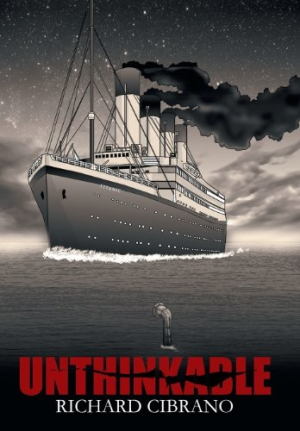Unthinkable
Anchored in history, Unthinkable is a well-developed thriller that sends readers back in time and onboard for a titanic disaster.
Populated with a host of recognizable characters, Richard Cibrano’s Unthinkable combines historical fact and fiction into an impeccably researched thriller about the sinking of the Titanic.
When former president Teddy Roosevelt shows up at the Pinkerton Detective Agency carrying news that the sinking of the Titanic might not have been quite what it seems, Allan Pinkerton skeptically agrees to look into the matter. With the help of one of the agency’s best, Frank Dimaio, a vast international conspiracy comes to light—one that might still be in play.
As a work of historical fiction, the book is beautifully rendered. Cibrano has clearly done his research. Details from the real lives of those such as Dimaio, Pinkerton, and Roosevelt are incorporated into the story. The scenes throughout the book are lush with detail, from a description of Times Square to the view from a dock at night: “The lights from a steamship moored to its berth form an incandescent outline against the black sky.”
However, it is this attention to detail that, while perhaps appropriate for a strictly historical work, drags the pace of a thriller. Particularly in the first half of the book, the complete historical backgrounds of the characters, while illuminating, don’t allow the proper amount of tension to build. The inclusion of Roosevelt’s son at their Saratoga home, for example, plays no role in advancing the plot and could easily be cut. Editing out such passages would allow for a smoother, faster pace overall, and trim some of the excess weight from this lengthy novel.
When the action is allowed to build, however, the result is gripping and the pages fly by, particularly in the scenes describing the sinking of Titanic from a sailor’s perspective, a fire in an apartment building, and the book’s conclusion.
The characters are well developed, with the known details of their lives fully fleshed out. Irony is employed successfully throughout, in that the fates of some of the more famous characters are well known. Overall, the writing is professional, though there is a problem with tense, slipping from present to past and back again. The concept of writing about a well-known historical event in the present tense is an intriguing one, as it forces a sense of immediacy and suspense, and might be quite effective if more carefully carried out. The plot itself contains numerous twists; as soon as something seems to be explained, another complication is introduced.
The inclusion of an author’s note at the end, explaining which parts of the book (a surprising number) are based on actual historical fact, is most welcome.
The book has a wide potential audience, from those who enjoy well-researched stories, to conspiracy theorists, to those simply fascinated by the story of the Titanic.
Reviewed by
Allyce Amidon
Disclosure: This article is not an endorsement, but a review. The publisher of this book provided free copies of the book and paid a small fee to have their book reviewed by a professional reviewer. Foreword Reviews and Clarion Reviews make no guarantee that the publisher will receive a positive review. Foreword Magazine, Inc. is disclosing this in accordance with the Federal Trade Commission’s 16 CFR, Part 255.

